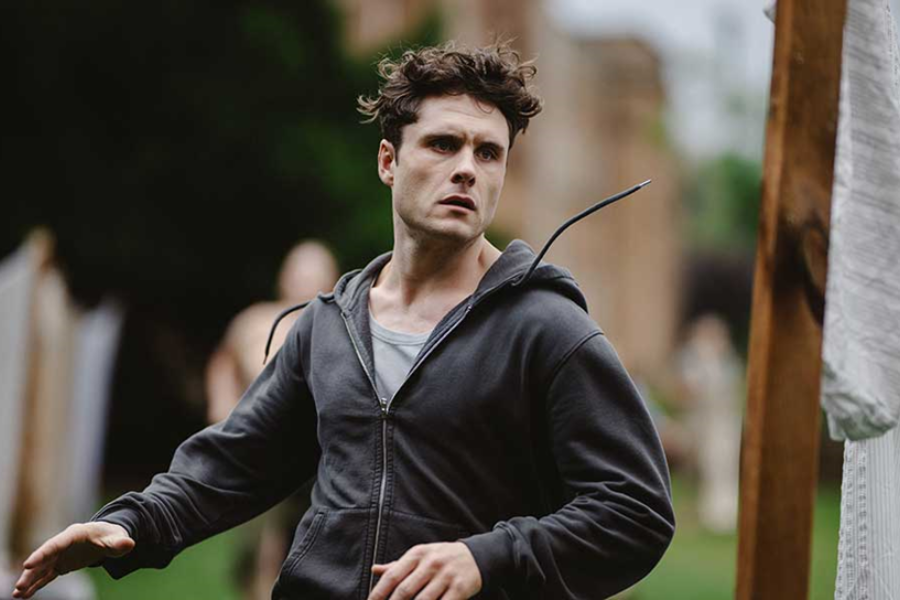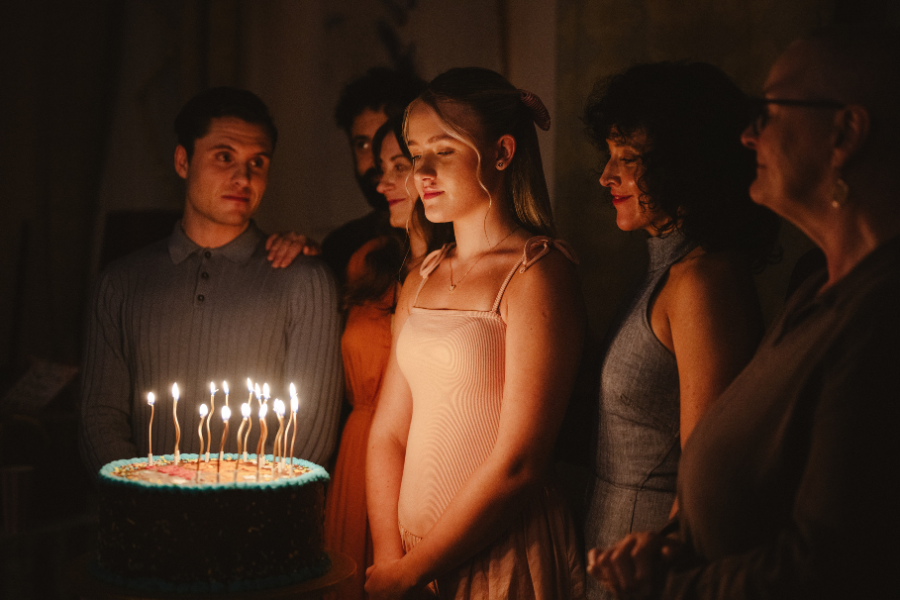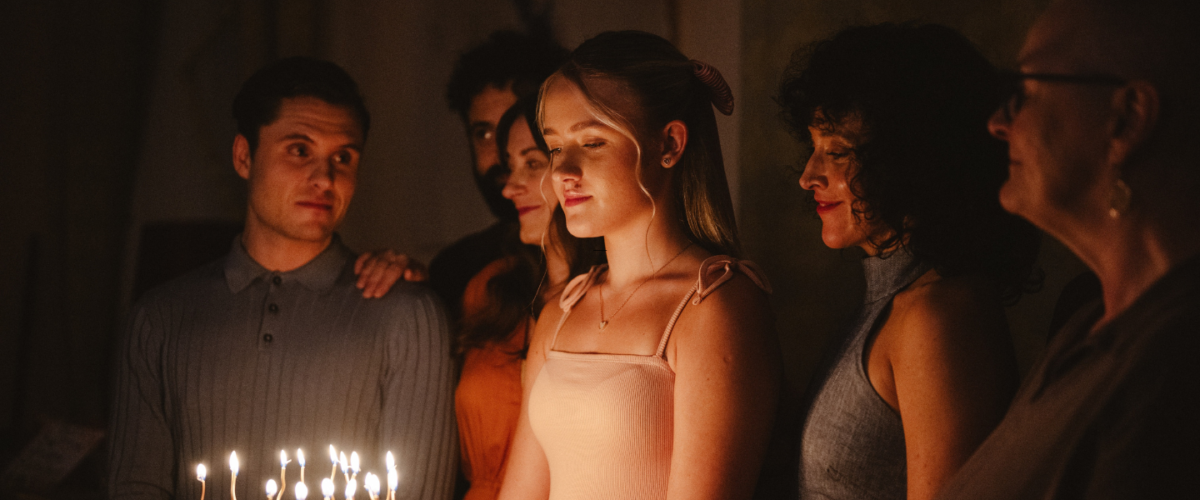September 30, 2025
Featuring a largely all-deaf lead cast and crew and a commitment to accessibility at every turn, Ted Evans’ debut feature Retreat delivers suspense while redefining what it means to make an inclusive film. Starring Anne Zander, James Boyle and Sophie Stone, Retreat is set in a remote deaf community, and follows Matt (Boyle) as the arrival of outsider Eva (Zander) shatters his idyllic life and forces him to confront his true identity.
Produced by The Fold and 104 Films, with financing from BFI, BBC Film, and Creative UK‘s West Midlands Production Fund, and with XYZ handling sales, Retreat was committed from the outset to creating a fully accessible set. In an industry where deaf and disabled talent remain among the most marginalised voices, systemic barriers – from inaccessible casting and crew recruitment processes to a lack of on-set adjustments – continue to limit opportunities. Retreat set out to dismantle those barriers at every stage, creating an environment where its cast and crew could thrive in a way that is still rare across the screen sector.
Early in the production, the team reached out to Filming in England for support in sourcing local crew – a collaboration that not only supported the production’s accessibility goals, but also contributed to the growing number of BSL Interpreters and Access workers now listed on our National Crew Directory.
Benjamin Bridger (Code of Silence, Heartstopper), one of the many Interpreters employed on the film, said:
“Working as an Interpreter on this production showed how essential accessibility is for creativity. By ensuring clear communication, deaf and hearing professionals were able to collaborate fully and bring an extraordinary vision to life. This production proved that accessibility and interpreters are not additions but essentials to making bold, inclusive cinema.”
Fresh from celebrating Retreat’s premiere at the 2025 Toronto International Film Festival, we caught up with producers Michelle Stein and Jennifer Monks (The Fold) to find out what it took to create “the world’s first deaf thriller.”
This case study shares their insights into the practical measures that helped shape a truly inclusive set for cast and crew alike.

What were your key accessibility goals at the outset of the production, and how were these shaped by the cast and crew involved?
We had a lot of pre-awareness that one of the main access needs on Retreat would be related to communication, due to the fact that our Director is deaf and had written a film which stars an almost exclusively deaf cast.
Our main aim was to make sure that anyone could communicate wherever they went on set or at base. We wanted to remove barriers to communication for all cast and crew so that communication was always free-flowing.
What specific adjustments or measures did you implement to ensure an accessible working environment for deaf cast and crew?
We hired a lot of Interpreters way in advance of the shoot. There are a relatively small amount of Interpreters with media or on-set experience in the UK so we had to book them around 6 months ahead of the shoot to ensure we had the people with the right skills and temperament to work on the shoot. Many Interpreters also have regular clients, so it was important that we gave them enough notice to relocate for prep and shoot. We had 12-14 interpreters on set every day depending on the amount of actors and background artists.
We also gave everyone who worked on the film deaf awareness training which taught them a small amount of basic BSL and made them feel confident about how to communicate with a deaf member of the team. We created a “working together” document that outlined best practice on a multilingual BSL and English set and some helpful pointers such as making sure rooms off-set were well lit and being aware of lines of sight so as not to obscure people who may be signing to each other.
In addition, we translated some of our policies into BSL and we had a wellbeing officer who used BSL as well as access to confidential remote interpreter services if a BSL user wanted to access wellbeing services without using an on-set interpreter. In addition, we had a Whisper track in which BSL Interpreters voiced over the signed dialogue so members of the team who were by the monitors who don’t know BSL could keep track of a rough translation of the dialogue being signed by the actors in front of camera.
Were there any challenges or misconceptions you encountered during pre-production or production around accessibility? How did you overcome them?
Not really! We worked with Access All Areas and sent everyone a questionnaire so they had an ‘Access Passport’ when they started with us so we understood everyone’s needs quite quickly.
What role did deaf consultants, crew members, or Access Coordinators play in shaping your approach?
We had sign language consultants on set but they were really creative consultants who made sure the sign language being used in front of camera was as planned in prep so this was less access-related and more of a creative role. We had some deaf crew members, almost all our cast were deaf and our director is deaf. He had certain preferences on how we work with Sign Language Interpreters, so these wishes were taken into account when devising our access plan.
We had a Co-ordinator from Access All Areas who generally captured access requirements and then passed them on to our Production Access Co-ordinator, Sara Kelly, who would then put reasonable adjustments in place. Once she joined the production in prep, she took over the plan the producers put in place and made it her own. She was in charge of confirming bookings and making sure interpreters were in the right places at the right times and were working the right hours.
We also had Mike Ballinger who was the Interpreter Co-ordinator and effectively the head of the interpreting department who liaised between the access department, production department and interpreting department (because it was its own, large department).
How did you ensure communication flowed effectively across departments, particularly where BSL (British Sign Language) or other access needs were involved?
Because we had so many deaf actors and crew working with us, we decided to take a departmental approach to Interpreters. It is usually best practice to have two Interpreters working with one deaf client to ensure the Interpreters can have breaks during the working day. However, we had so many deaf people on set and in the office that this would have resulted in too many bodies in tight spaces.
So we took a departmental approach where the correct amount of Interpreters could be found in each department so that if an actor was moving around costume and make-up and then going on set, they would find one or two Interpreters in each of those spaces.
Were any new tools, technologies, or working practices adopted as a result of the access needs of the team? Would you recommend them to others?
It’s probably a new idea to translate our production company policies into BSL – I’m not sure anyone has done that on a film before but I might be wrong! We realised we had some documentation that was extremely long and written in very dense English and for many of our cast and crew English may not be their first language, which is why we chose to translate some key information. Just generally sharing information visually in video form in BSL is not something common on productions and we realised there was a need for it.
We had a whisper track on this film which helped anyone who would usually be listening to audible dialogue to follow the lines the actors were performing in sign language. This track was recorded on a separate channel and could also be used in the edit, though our editor preferred to follow the visual rhythm of the sign language instead. The BBC Drama Reunion used this and we adopted this practice for Retreat.
We chose to use both a standard and Easy-Read call sheet on this shoot. This was not specifically for our deaf cast, we just decided to make daily information as accessible as possible.
How did accessibility considerations influence scheduling, budgeting, or crew planning?
We strongly believe that time is an access requirement. We had a more complex flow of communication on set and as a result asked for more time from our funders to shoot the film. We had 6 weeks. The access budget of the film was very high and was ringfenced. Our funders were excellent in understanding that this film came with necessary additional costs that they were happy to fund. However, if navigated well, some of the cost of Interpreters and other support workers can be reclaimed from the UK government’s Access To Work scheme which is a scheme productions should know about. We had a dedicated consultant, Sam Calder Bray, who acted as our representative with Access to Work and he managed to help many people get access to funding they were entitled to through that scheme. We wanted deaf crew involved in our project and the BBC TV drama Reunion had just shot before us and had trained up some great people so we were able to take crew from that on and give them further experience.
What did you learn through this process that might change how you approach accessibility on future productions?
We knew before going into this film that access should be baked into our production plan, but it should be planned for and baked in on every production. Even if characters are not explicitly written as deaf or disabled, the set should be accessible in case a deaf or disabled actor is cast. And there should not be an assumption that crew will not be deaf or disabled, it should be assumed that there’s a high chance reasonable adjustments will be made by the production and ideally budget put aside for this. We will be even more mindful of accessibility on our future productions and intend to hire an access co-ordinator on every production going forwards.
What impact did the accessible approach have on team culture or creative outcomes during production?
Many people learned something new on this production and enjoyed the experience of working on a film that was primarily shot in BSL. They came away from the production with new skills. The film set ran like any other set – it had the same wonderful creative moments and also problems that had to be navigated. I do think that our approach to access and inclusivity also encouraged people to feel like they were in a supportive environment where any concerns would be greeted with understanding.
What advice would you offer to other producers looking to make their sets more inclusive, particularly for deaf talent and crew?
There have now been multiple productions that have been led by deaf creatives, with deaf talent at their core and it’s important to keep building on the experience of others. I’d highly recommend producers working with deaf talent to speak to people who have run deaf sets before. We had worked with Ted on a smaller scale before so brought that knowledge to Retreat, but we also visited the set of Reunion so that we could learn from them. It’s important to share knowledge and ask for help.
I think it’s important to make sure you set out from the start of production that the production prioritises inclusivity and to ensure that is stated clearly so that it encourages an openness and dialogue. It’s also very important to be flexible – if something isn’t working, you can change it and be responsive to people’s needs.
In an industry where deaf and disabled talent are too often sidelined, meaningful opportunities can be life-changing – both for the professionals involved and for the audiences who get to experience their work. The latest Creative Diversity Network Diamond Report shows that deaf and disabled professionals make up just 8.7% of off-screen roles and 10.4% of on-screen roles – the smallest proportion of disabled contributions in the UK screen sector.
Retreat proves that productions don’t have to accept these odds. By embedding accessibility into every part of the process, the team not only told a compelling story but also opened doors for deaf and disabled talent. It’s a blueprint for how inclusive filmmaking can work in practice, and a call to the industry to follow suit.
You can catch Retreat next at the 69th BFI London Film Festival 8th – 19th October.
If you’re a BSL Interpreter, Access worker or crew member looking for Film & TV job opportunities, register for free on the Filming in England Crew Directory.








